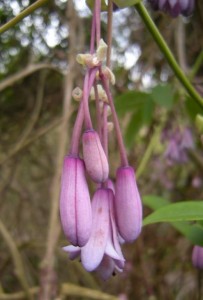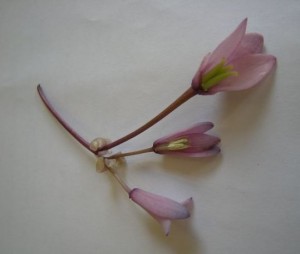Holboellia latifolia is a fellow member of the family Lardizabalaceae along with the previously described Akebia trifoliata. The plant driving itself upwards into the light on the Chinese Hillside was collected in Nepal in 1992 by members of the Edinburgh Makalu Expedition. In the wild, it is found growing in the Arun Valley at 2,750 metres through laurel forest.
The evergreen leaves are composed of varying numbers of leaflets, to a maximum of seven. Fresh growth is delicately translucent and slightly tinted bronze to protect from the higher-altitude UV rays of the sun in the Himalaya region. Our specimen reaches eight metres to the top of the supporting canopy.
Separate male and female flowers appear from nodes on the stems of all ages – deep in shade on the oldest wood to canopy top in bright sunshine. The six fleshy sepals are a mauve to purple shade; the male and female flowers are produced separately but mixed in the clusters. The male flowers are slightly smaller in cross section than the female. Both give off a heavy scent. The six free anthers produce copious amounts of white pollen.


